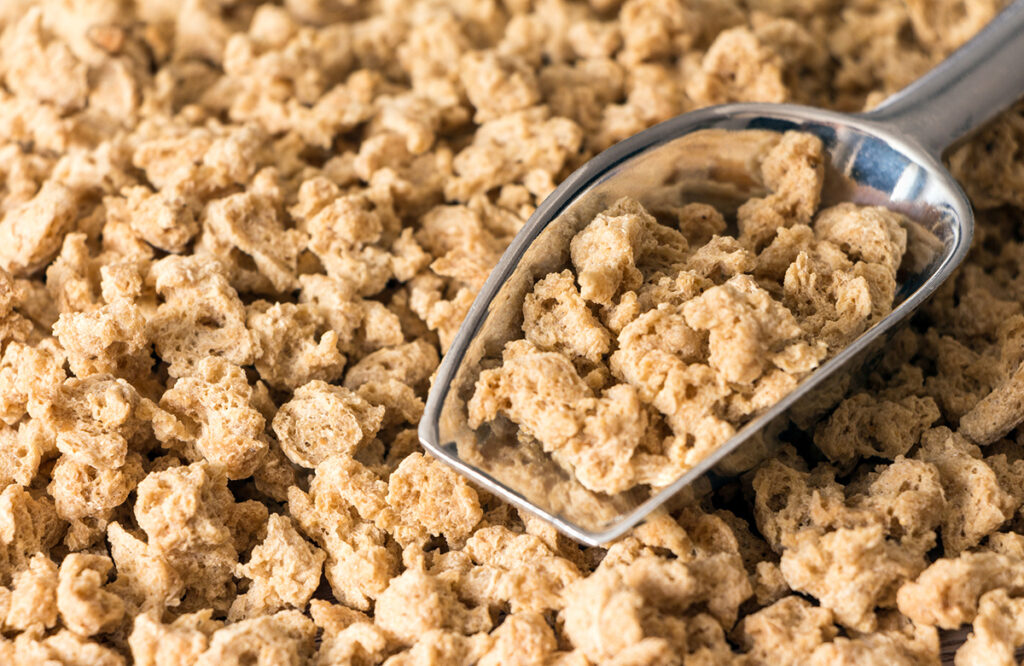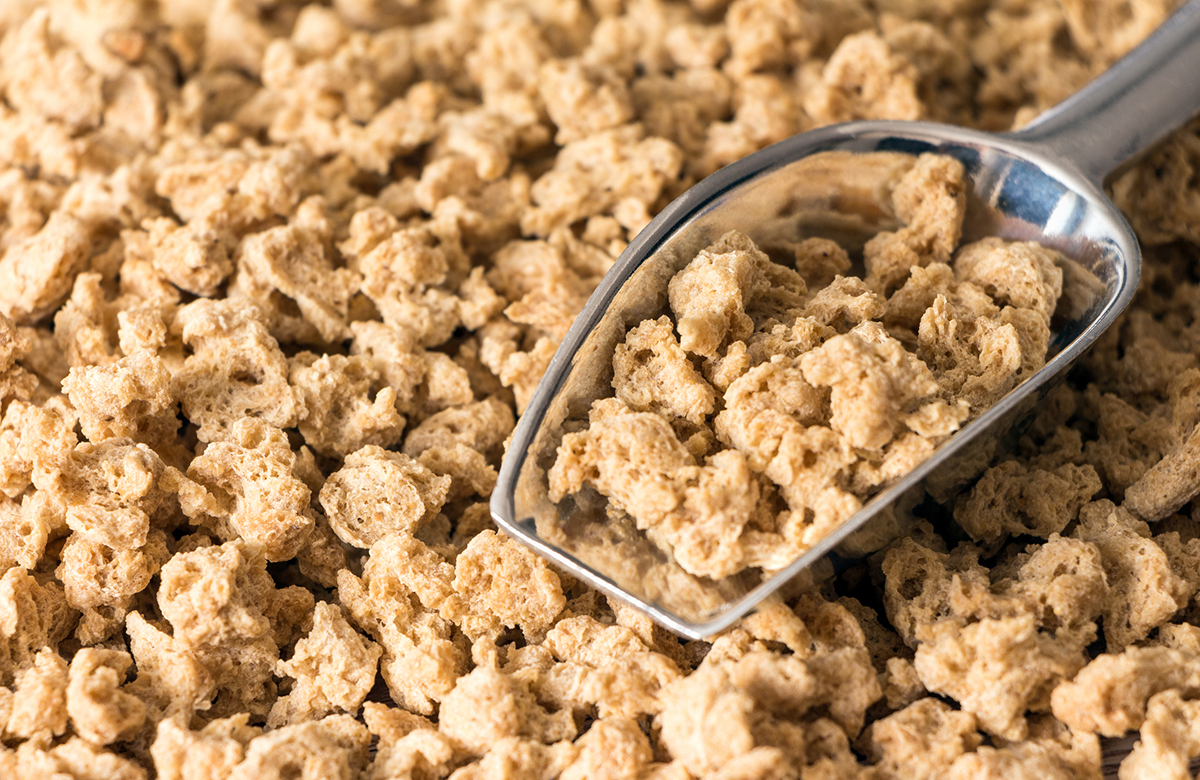
As the world’s most abundant oilseed crop, soybeans supply the most common source of vegetable protein in animal feeds and human foods. Although soy’s prime purpose is to produce meal for animal feed, the meal remaining after oil extraction can be further processed into other useful ingredients. In the form of texturized soy protein (TSP), soybeans provide an inexpensive meat replacement or meat extender to help feed meat lovers, vegans, and vegetarians alike.
Found in most soy meat substitutes as well as meat products, TSP is available in a variety of shapes and flavors meant to mimic the taste and texture of real meat. As an inexpensive and widely available alternative, TSP has been growing in popularity since the 1960s—both as a meat replacement in plant-based diets and as a key ingredient in meat-based dishes like hamburger patties, sauces, chilis, and more.
Here’s a closer look at how soybean meal is processed into TSP.
TSP versus TVP
While TSP specifically refers to texturized protein from defatted soy meal, textured protein can be made from any protein-rich seed meal. Although soy is most commonly used because of its abundance, textured vegetable protein (TVP) can also be made from peas, peanuts, lentils, cottonseed, corn, or wheat instead.
These textured protein derivatives are made from meal left over from either solvent extraction, which uses a chemical like hexane to separate oil from the solid seed material, or mechanical extraction, which uses force to squeeze oil from the seeds without any chemicals. As consumers opt for more natural food sources amidst growing health and safety concerns, non-GMO and organic ingredients are becoming more valuable. Many European countries have already banned GMO crops, driving the growth of organic and non-GMO TVP.
Since solvent extraction relies on toxic chemicals, and large solvent extractors are more likely to source GMO seed material, organic and non-GMO texturized soy protein must come from mechanical processing plants. Once the meal leaves the oil mill, that’s when the TSP (or TVP) process begins.
Also read: Calculating the Growth Potential of Organic Soybean Meal
Texturized soy protein processing
After defatted soybean meal leaves the mechanical expeller press, it is dried and ground before it leaves the oil mill. This meal can contain up to 10% residual oil to be successfully textured and should have a protein dispersity index (PDI) between 45-55% (although this can range from 20-80%). The PDI, which measures the percentage of total protein dispersible in water, tends to be lower after solvent extraction and higher after mechanical extraction due to the high temperatures involved in the latter process.
As soon as the meal arrives at a texturized soy protein processing plant, it is pulverized again into a finer flour consistency of about 150 microns. This ground meal passes through an expander or preconditioner, where steam injection conditions the meal and elevates the moisture level to about 25% while quickly cooking it at 245 degrees for about 30 seconds. These temperatures help deactivate the growth inhibitors and antinutritional factors found in raw soybean while denaturing the protein to render it digestible.
Then, the preconditioned meal mixture enters an extruder, where high pressures and temperatures restructure the proteins, causing the product to expand as it’s discharged through a die. A cutter head controls the size and shape of the texturized soy protein that leaves the extruder—creating small flakes, large chunks, and even strips, cubes, or nuggets to resemble various cuts of meat. While the flakes look like ground meat, the extruded chunks mimic real meat’s fibrous, spongy structure and chewy texture, making TSP popular as a substitute or supplement for many meat dishes.
Raw TSP is flavorless, so colors, flavors, and seasonings are often added to extruded products before they’re dried and packaged for sale. Textured soy protein can take on flavors like beef, chicken, bacon, or salmon, giving this product great versatility to suit a wide range of palates. The moisture level of TSP varies from 8-10%, and it readily absorbs water during meal preparation. Adding one cup of water to one cup of dried protein will reconstitute to approximately three cups of crumbly soy.
Since TSP processing requires several steps, from cooking to expanding to extruding, the most efficient equipment combines these stages into one system, like the Expander-Extruder-Cooker (EEC) from Anderson. One of the most durable, versatile continuous pressure cookers on the market, the EEC also offers one of the lowest-cost solutions for processing TVP.
Also read: Extrusion Technology Crucial for the Plant Protein Market
The benefits of TSP
Whether it’s used to replace the taste and texture of meat in vegetarian substitutes, mixed with ground beef to create more affordable patties and sauces, or even added to animal feed or pet food — texturized soy protein packs plenty of benefits. For example:
- TSP has a long shelf life of between one to two years. With lower bacteria counts than meat, vegetable protein lasts much longer and doesn’t require refrigeration, which is why it’s often used in canned and jarred products.
- TSP contains at least 52% protein, 34% carbohydrates, and 1% fat, making it a nutritious ingredient in any diet. Soy protein contains all the essential amino acids required by the human body, with a protein efficiency ratio of at least 80%.
- As a low-cost protein source with wide availability, TSP provides an economical food source around the globe — reducing costs without lowering the nutritional value. It offers much-needed dietary protein in plant-based diets and in underserved regions facing food insecurity, where meat is unavailable or expensive.
Because of these benefits, textured soy protein represents a growing market potential for processors. Although conventional, solvent-extracted TSP is relatively inexpensive (fetching between $700-$750/ton) and mechanically processed TSP is slightly higher (at $800-$850/ton), specialized markets can command twice that price. Non-GMO TSP sells for about $950-$1,000/ton, while organic TSP sells for $1,600-$1,700/ton.
Currently valued at approximately $880 million, the global market for texturized soy protein is expected to reach $1.6 billion by 2031. Europe has a significant market share, accounting for 45% of global TSP sales in 2021. While conventional products make up most ($705.5 million) of this worldwide demand, the growing interest in organic and non-GMO protein supplements is set to soar.
Seizing the TSP opportunity
As the worldwide demand for texturized soy protein continues to grow, mechanical soybean processor plants are well-positioned to capitalize on this lucrative niche. To tap into the TSP market, plants need the most efficient, economical processing systems to extract the oil from the seed and then transform the meal from a mere byproduct into a valuable ingredient like TSP.
The extraction engineers at Anderson International have decades of experience building, implementing, and refining these oilseed processing systems around the world. With a growing portfolio of time-tested equipment like the EEC—paired with the expertise to optimize it—Anderson can engineer a complete solution designed to maximize your plant’s TSP profits.
For more information about the EEC and other TSP processing equipment, contact Anderson International.
